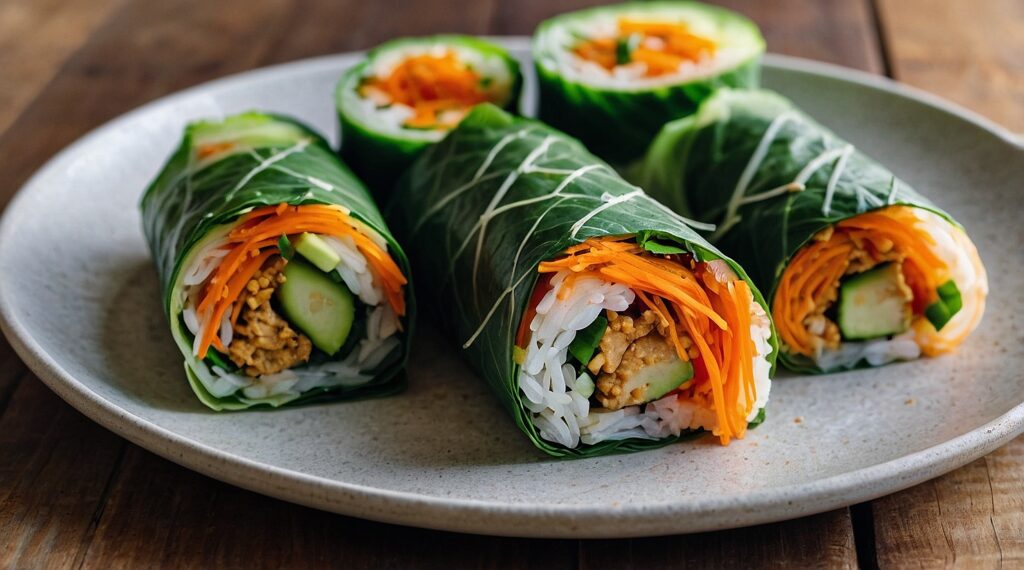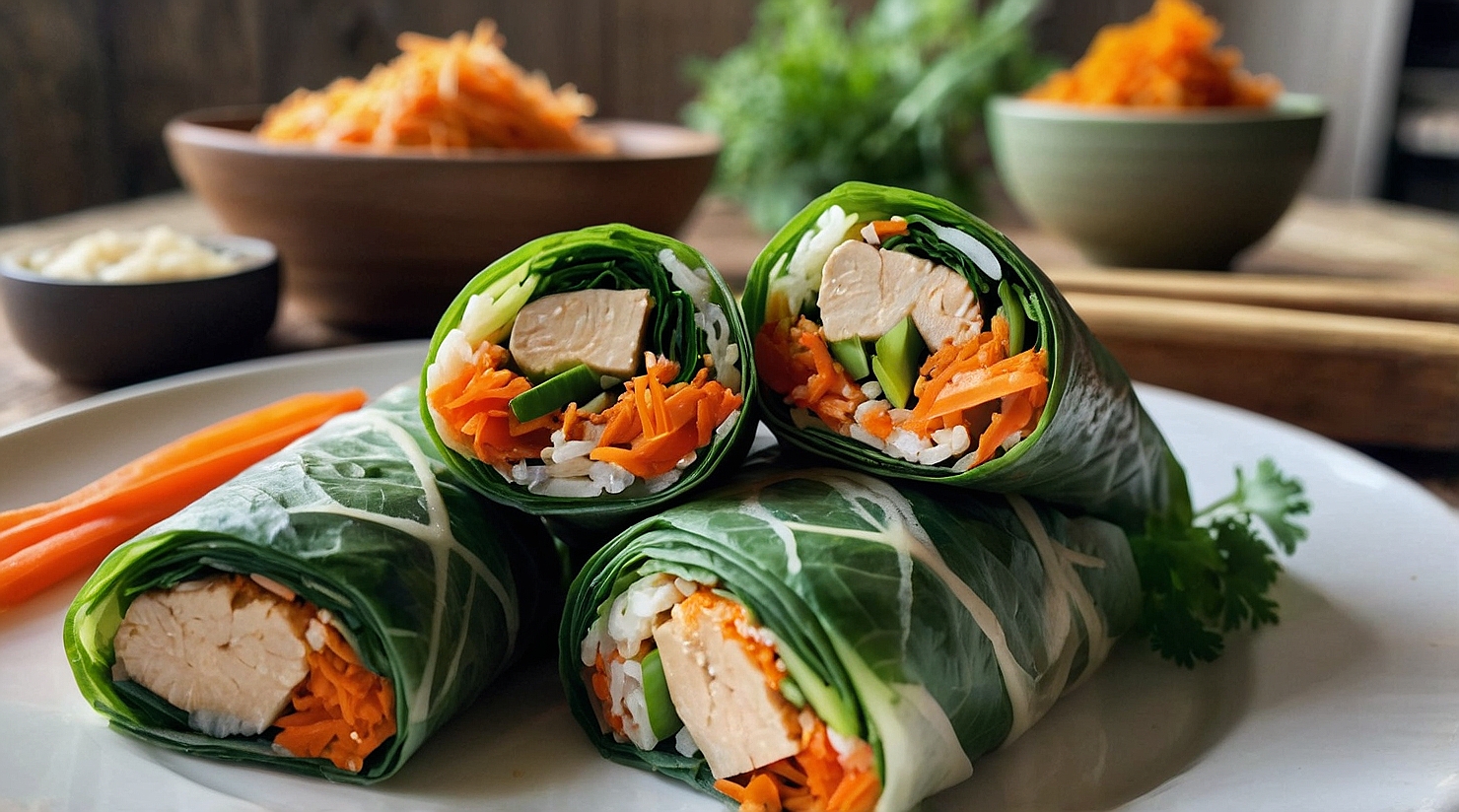Introduction: What Are Summer Rolls?
Summer rolls, also known as Vietnamese spring rolls or Gỏi cuốn, are a traditional dish originating from Vietnam. They are known for their freshness, versatility, and health benefits. Unlike fried spring rolls, summer rolls are wrapped in rice paper and served fresh, not fried, making them a lighter, healthier option.
What makes summer rolls particularly appealing is their adaptability—you can use a wide range of ingredients to suit personal preferences or dietary needs. Whether you’re a fan of shrimp, tofu, or a mix of fresh vegetables and herbs, summer rolls can be customized to be vegan, gluten-free, or protein-packed.
Why Are Summer Rolls So Popular?
- Health benefits: Rich in vegetables and lean proteins.
- Easy to prepare: Minimal cooking involved.
- Great for meal prep: They can be stored for a few hours and served fresh.
- Versatility: The ingredients can be mixed and matched according to dietary preferences.
For more ideas on variations and detailed recipes, check out this Shrimp Summer Rolls Recipe that explains different techniques for creating the perfect roll.
Traditional Ingredients in a Summer Roll
When discussing the ingredients in a traditional summer roll, it is important to highlight the simplicity and freshness of the components. Traditional summer rolls typically consist of a few staple ingredients, which together create a balanced and nutritious meal.
Rice Paper Wrappers
The foundation of a summer roll is the rice paper wrapper. These translucent, round sheets are made from rice flour and water, making them gluten-free. Rice paper is delicate yet stretchy, and it softens quickly when dipped in warm water. Because the wrapper is thin and flexible, it allows the vibrant ingredients inside to shine through, making the summer roll visually appealing as well.
| Rice Paper Wrapper Nutrition (Per Wrapper) | Value |
| Calories | 35 |
| Carbohydrates | 8g |
| Protein | 0.5g |
| Gluten-Free | Yes |
For detailed instructions on selecting and preparing rice paper, refer to our article on Shrimp Summer Rolls for more insights.
Rice Noodles (Vermicelli)
Next comes the rice vermicelli noodles, which provide a light and chewy texture. These noodles are thin, white, and made from rice flour. Before adding to the summer rolls, they are briefly boiled and then rinsed with cold water to stop the cooking process. Rice noodles act as a neutral base for the more flavorful components like herbs and protein.
Protein Options
- Shrimp: Shrimp is a traditional protein used in summer rolls due to its delicate flavor and low-calorie profile. Shrimp is usually boiled, peeled, and sliced in half lengthwise before being added to the roll.
- Pork: Thinly sliced pork adds a savory element to summer rolls. It is often boiled and sliced into small, bite-sized pieces that complement the shrimp and vegetables.
- Tofu: For vegetarians or those seeking a lighter option, tofu is an excellent source of protein. It can be pan-fried or baked to give it a slightly crispy texture before being wrapped in the roll.
Fresh Vegetables and Herbs
One of the best aspects of summer rolls is the array of fresh vegetables and herbs used to provide crunch, flavor, and nutrients. Typical vegetables include:
- Lettuce: Provides bulk and acts as a cushion for the other ingredients.
- Carrots and Cucumbers: Thinly sliced for added crunch and freshness.
- Herbs (Mint, Thai Basil, Cilantro): These fresh herbs give summer rolls their distinctive, fragrant flavor. The combination of mint and Thai basil is particularly refreshing and pairs well with the other ingredients.
Modern and Creative Ingredient Variations for Summer Rolls
While traditional summer rolls are simple and fresh, modern versions have evolved to include a wide variety of ingredients to suit different tastes and dietary requirements. Let’s explore some creative and delicious variations.
Alternative Proteins
- Chicken: Grilled or poached chicken makes a great protein option. It’s lean, versatile, and can be flavored with Asian spices for an added twist.
- Fish: Salmon or tuna adds a rich and flavorful component to summer rolls. Smoked or seared fish can be used to give an extra depth of flavor.
- Eggs: Scrambled or boiled eggs are also a popular addition for those looking for a vegetarian but protein-rich roll.
Vegetarian and Vegan Ingredients
- Tempeh or Seitan: These plant-based proteins offer a more textured bite than tofu and are great for vegan summer rolls.
- Avocado: For a creamy texture, avocado slices are a perfect addition.
- Mango: Adding mango to your summer rolls gives a sweet and tropical flavor that complements the savory ingredients.
Grains and Seeds
- Quinoa: For added protein and fiber, quinoa can be used in place of rice noodles.
- Sesame Seeds: Sprinkling sesame seeds inside or on top of the summer roll adds a nutty flavor and aesthetic appeal.
How to Assemble a Summer Roll: Step-by-Step Guide
Making summer rolls at home is a straightforward process, but a few essential steps ensure that they turn out perfect every time.
For more visual inspiration and tips, check out this Shrimp Summer Rolls Recipe to see the step-by-step process in action.
Dipping Sauces for Summer Rolls
A summer roll isn’t complete without a delicious dipping sauce. Here are some popular options:
- Peanut Sauce: A rich and creamy sauce made from peanut butter, hoisin sauce, and lime juice.
- Hoisin Sauce: A sweet and tangy sauce that complements the freshness of the rolls.
- Nuoc Cham (Vietnamese Dipping Sauce): This traditional sauce combines fish sauce, lime juice, sugar, garlic, and chili for a punch of flavor.
- Soy and Ginger Sauce: A light and refreshing dipping sauce perfect for a vegan version of summer rolls.
If you’re looking for an exciting twist, consider adding chopped nuts or fresh herbs to your peanut sauce. For more inspiration, check out the detailed instructions in the Shrimp Summer Rolls Recipe.
Nutritional Benefits of Summer Rolls
Summer rolls are a healthy, low-calorie option that packs in a lot of nutrition. Here are some of the key benefits:
| Nutrient | Source | Benefits |
| Low in Calories | Shrimp, Vegetables | Supports weight management |
| High in Fiber | Lettuce, Carrots, Cucumber | Aids in digestion |
| Rich in Protein | Shrimp, Tofu, Chicken | Helps in muscle repair and growth |
| Vitamins | Herbs, Vegetables | Boosts immune function |
| Gluten-Free | Rice Paper, Rice Noodles | Safe for people with gluten intolerance |
The combination of fresh vegetables, lean proteins, and gluten-free rice paper makes summer rolls a nutrient-dense, low-fat, and heart-healthy meal.
To learn more about how to enhance the nutritional profile of your summer rolls, check out our Shrimp Summer Rolls Recipe.

Frequently Asked Questions (FAQs) About Summer Rolls
Are summer rolls healthy?
Yes! Summer rolls are low in calories, rich in fresh vegetables, and provide lean proteins, making them an excellent option for a balanced meal.
Can I make summer rolls in advance?
While summer rolls are best eaten fresh, they can be made a few hours in advance. To store them, wrap each roll individually in plastic wrap and refrigerate. This prevents them from drying out.
For tips on maintaining freshness and preventing hardening, check out this article on How to Keep Summer Rolls from Hardening.
How do I prevent the rice paper from tearing?
Make sure not to over-soak the rice paper and avoid overfilling the rolls. Work gently when rolling to prevent tears.
Can I freeze summer rolls?
No, freezing summer rolls is not recommended as the rice paper becomes soggy and difficult to eat once thawed.
What’s the difference between summer rolls and spring rolls?
The main difference is that summer rolls are served fresh and spring rolls are fried. Summer rolls use rice paper, while spring rolls typically use wheat wrappers.
Tips for Serving and Presenting Summer Rolls
- Plating: Serve summer rolls on a platter with dipping sauces on the side. Use a garnish of herbs or sliced vegetables for extra color.
- Portioning: If making for a party, cut each roll in half for easier handling.
- Accompaniments: Serve with a side of Asian noodle salad or a light soup for a complete meal.
- Drinks: Pair with iced green tea, lemonade, or a light sparkling drink for a refreshing combination.
For a comprehensive guide on serving and storing, refer to Shrimp Summer Rolls Recipe.
Conclusion:
Summer rolls are not only a healthy and versatile meal option but also incredibly easy to make. With a balance of fresh vegetables, lean proteins, and herbs, they offer a satisfying and nutrient-packed dish that can be enjoyed any time of year. Whether you’re a fan of the traditional shrimp version or looking to try new ingredients like avocado or quinoa, summer rolls are a fun and customizable dish that everyone can enjoy.
So why not give them a try? Get creative with the ingredients and discover your favorite combination. Summer rolls are sure to become a staple in your fresh meal repertoire!
For more detailed variations, be sure to visit the Shrimp Summer Rolls Recipe.

